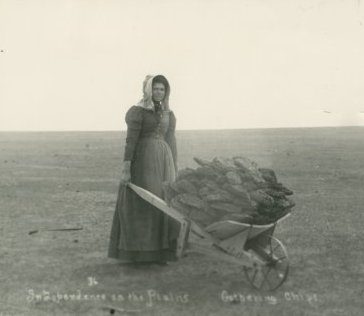When temperatures drop and you reach for another log to throw on the fire, just remember it could be worse. You could be grabbing a cow chip.
Keeping warm in the winter was a real problem in the 1800s on the treeless Kansas prairie. Called “bois de vache” or “wood of the buffalo” by French explorers, dried buffalo dung or “chips” became the main fuel source. Buffalo chips were nearly odorless and clean to handle after drying in the hot sun for a few weeks. Because they burned with little flame, “bois de vache” were perfect for heating and cooking, and they were readily available to travelers on the Santa Fe Trail who would fill the underbelly of their wagons with the precious commodity. This fuel supply was soon depleted when the buffalo were killed off. Settlers then began using cow chips.
Quirky as it may sound, there was a science to picking out the better quality chips. A chip from cattle on lush, tender grass was almost worthless as it burned fast and didn’t last long. Those that had been exposed to wind and rain gave off very little heat and produced a great deal of ash. Good, mature buffalo grass in the fall made the ideal chips. The chips held their shape, burnt well but not fast, and furnished the maximum B.T.U.’s.
Cow chips were gathered and stored for the winter as autumn set in, and it was not uncommon to see a huge pile stacked outside of a prairie home. Cooking with the chips did not change the taste of the food, but many women had quite the aversion to bringing cow manure into their homes to cook with. They became adept at cooking with the fuel, learning to stir with one hand and tossing another chip on the fire with the other.
The famous photograph of Ada McColl steering a wheelbarrow full of chips was taken around 1893 near her Lakin home. Entitled “Independence on the Plains. Gathering Chips,” the image is well known in historical circles and has appeared in a number of publications and on the front cover of Joanna Stratton’s Pioneer Women. The Finney County Historical Society even used the image as the official FCHS logo for a time.
Ada moved from Medicine Lodge in 1886 to Lakin where her family homesteaded. She had not planned on being one of the most well-known pioneer women models but instead wanted to learn how to operate a camera. She began serving as an apprentice at H.L. Wolf’s photography shop in Garden City. Wolf gave Ada a few pointers on using the camera her parents had bought her, and she went on to create family portraits and to document the Kansas prairie. She kept records of photography expenses and numbered and/or named all of her photographs. “Gathering Chips” was taken by Ada’s mother, Polly McColl. Polly also took a turn posing behind the wheelbarrow of prairie woodfire in a lesser known photo. Wolf processed Ada’s photographs from her glass negatives in his studio and may have received credit for some of her work as dozens of copies of the “Cow Chip Lady” were printed in the 1890s.
While visiting relatives in Iowa in 1893, Ada met her future husband. She moved to Iowa in 1895, leaving her negatives and photograph collection behind with Wolf. In a letter dated March 30, 1895, Wolf told Ada that he would send them to her at any time should she want them. Apparently, she never asked him to send them to her. When Wolf sold out, he left the plates in his studio, and the new owner took possession of them.
After nearly 100 years of obscurity and speculating who the woman in the photograph was, Ada McColl was finally identified as the “Cow Chip Lady” in 1984 when her great-granddaughter presented several pieces of evidence to the Kansas State Historical Society, completing a quest that had been started in 1964 by Ada’s daughter, Erma Pryor. Ada Catherine McColl Thiles died in Iowa in 1956 at the age of 85, but her iconic photo has made the “Cow Chip Lady” a lasting figure in American (and Lakin) history.

Sources: Kansas State Historical Society; The Sequoyan Volume 6 Number 2; nebraskastudies.org; ancestry.com; and museum archives.
